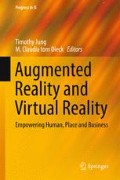Abstract
Augmented Reality (AR) is currently one of the most popular technologies among global technological applications. Aside from completely immersing the user in a synthetic environment in which the user cannot experience the real world around herself, as Virtual Reality (VR) technology does, AR superimposes the computer-generated data while allowing the user to enhance her perception of reality and of the surrounding. Furthermore, AR has many application areas, varied from medical treatment to educational purposes. Particularly, AR technology is employed in tourism sector, increasing the involvement of touristic activity while diversifying the bundle of tourism experiences. The literature, however, is insufficient, in terms of capturing the main impact of AR technology on the satisfaction levels of tourists. This paper aims to fill the gap by investigating the past literature on AR technology and then presenting a naïve model where the significant effect of AR technology can be seen on the basis of tourist satisfaction.
Access this chapter
Tax calculation will be finalised at checkout
Purchases are for personal use only
References
Ajanki, A., Billinghurst, M., Gamper, H., Jarvenpaa, T., Kandemir, M., Kaski, S., et al. (2010). An augmented reality interface to contextual information. Virtual Reality, 15(2–3), 455–470.
Azuma, R. T. (1997). A survey of augmented reality. Presence: Teleoperators and virtual environments, 6(4), 355–385.
Basel Augmented Reality Tourist Guide (2011). Accessed December, 2016, from http://www.perey.com/AugmentedRealityForBasel/.
Benyon, D., Quigley, A., O’Keefe, B., & Riva, G. (2014). Presence and digital tourism. AI & SOCIETY, 29(4), 521–529.
Casella, G., & Coelho, M. (2013). Augmented heritage: Situating augmented reality mobile apps in cultural heritage communication. Proceedings of the 2013 International Conference on Information Systems and Design of Communicatio (138–140)
Chase, J. (2014). These augmented reality apps take travel to a whole new level. Accessed December, 2016, from http://www.cntraveler.com/stories/2014-03-31/best-augmented-reality-travel-apps.
Fritz, F., Susperregui, A., & Linaza, M. T. (2005). Enhancing cultural tourism experiences with augmented reality technologies. 6th International Symposium on Virtual Reality, Archaeology and Cultural Heritage (VAST).
García-Crespo, A., Chamizo, J., Rivera, I., Mencke, M., Colomo-Palacios, R., & Gómez-Berbís, J. M. (2009). SPETA: Social pervasive e-Tourism advisor. Telematics and Informatics, 26, 306–15.
Genç, R. (2012). Tourist consumption behavior and quality-of-life. In Handbook of tourism and quality-of-life research (pp. 135–148). Netherlands: Springer.
Jung, T., Chung, N., & Leue, M. C. (2015). The determinants of recommendations to use augmented reality technologies: The case of a Korean theme park. Tourism Management, 49, 75–86.
Kounavis, C. D., Kasimati, A. E., & Zamani, E. D. (2012). Enhancing the tourism experience through mobile augmented reality: Challenges and prospects. International Journal of Engineering Business Management, 4, 1–6.
Martínez-Graña, A. M., Goy, J. L., & Cimarra, C. A. (2013). A virtual tour of geological heritage: Valourising geodiversity using Google Earth and QR code. Computers & Geosciences, 61, 83–93.
Moore, G. (1965) Cramming more components onto integrated circuits. Electronics, 38(8), 114–117.
Museum of London: Streetmuseum (2010). Retrieved December, 2016, from http://www.museumoflondon.org.uk/Resources/app/you-are-here-app/index.html.
Osterlund, J., & Lawrence, B. (2012). Virtual reality: Avatars in human spaceflight training. Acta Astronautica, 71, 139–150.
Rasinger, J., Fuchs, M., Beer, T., & Hopken, W. (2009). Building a mobile tourist guide based on tourists’ on-site information needs. Tourism Analysis, 14, 483–502.
Real Business (2016). Will 2017 be the watershed for business using augmented reality? Retrieved December, 2016, from http://realbusiness.co.uk/tech-and-innovation/2016/11/22/will-2017-be-watershed-businesses-using-augmented-reality/.
Suh, Y., Shin, C., Woo, W., Dow, S. & MacIntyre, B. (2010). Enhancing and evaluating users’ social experience with a mobile phone guide applied to cultural heritage. Personal and Ubiquitous Computing, 14(8), 1–6.
Takada, D., Ogawa, T., Kiyokawa, K., Takemura, H. (2009). A context-aware AR navigation system using wearable sensors. Proceedings from the 13th International Conference Human-Computer Interaction, 1–10.
Tokusho, Y., & Feiner, S. (2009). Prototyping an outdoor mobile Augmented Reality street view application. Paper presented at ISMAR 2009, 8th International Symposium on Mixed and Augmented Reality: Let’s go out: Workshop on outdoor mixed and augmented reality, Orlando, FL, USA.
Tom Dieck, M.C., & Jung, T. (2015). A theoretical model of mobile augmented reality acceptance in urban heritage tourism. Current Issues in Tourism, 18, 1–21.
Tuscany+. (2010). Retrieved December, 2016, from http://www.turismo.intoscana.it/allthingstuscany/aroundtuscany/tuscany‐the‐first‐augmented‐realitytourism‐application/.
Umlauft, M., Pospischil, G., Niklfeld, G., & Michlayr, E. (2003). Lol@, a mobile tourist guide for UMTS. Information Technology and Tourism, 5(3), 151–164.
Uzialko, A. C. (2016). Augmented reality check: Innovative ways businesses are embracing AR. Retrieved December, 2016, from http://www.businessnewsdaily.com/9245-augmented-reality-for-business.html#sthash.ZqS1PuKq.dpuf.
Van Krevelen, D. W. F., & Poelman, R. (2010). A survey of augmented reality technologies, applications and limitations. International Journal of Virtual Reality, 9(2), 1.
Wither, J., DiVerdi, S., & Höllerer, T. (2009). Annotation in outdoor augmented reality. Computers & Graphics, 33(6), 679–689.
Yovcheva, Z., Buhalis, D., & Gatzidis, C. (2013). Engineering augmented tourism experiences. In L. Cantoni & Z. Xiang (Eds.), Information and communication technologies in tourism 2013 (pp. 24–35). Berlin: Springer.
Yovcheva, Z., Buhalis, D., & Gatzidis, C. (2014). Empirical evaluation of smartphone augmented reality browsers in an urban tourism destination context. International Journal of Mobile Human Computer Interaction, 6(2), 10–31.
Yu, D., Jin, JS., Luo, S., Lai, W., & Huang Q. (2010). A useful visualization technique: A literature review for augmented reality and its application, limitation and future direction. In M. L. Huang, Q. V. Nguyen, & K. Zhang (Eds.), Visual information communication, (311–317). USA: Springer.
Author information
Authors and Affiliations
Corresponding author
Editor information
Editors and Affiliations
Rights and permissions
Copyright information
© 2018 Springer International Publishing AG
About this chapter
Cite this chapter
Genç, R. (2018). The Impact of Augmented Reality (AR) Technology on Tourist Satisfaction. In: Jung, T., tom Dieck, M. (eds) Augmented Reality and Virtual Reality. Progress in IS. Springer, Cham. https://doi.org/10.1007/978-3-319-64027-3_8
Download citation
DOI: https://doi.org/10.1007/978-3-319-64027-3_8
Published:
Publisher Name: Springer, Cham
Print ISBN: 978-3-319-64026-6
Online ISBN: 978-3-319-64027-3
eBook Packages: Business and ManagementBusiness and Management (R0)

